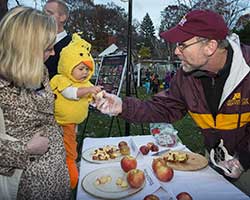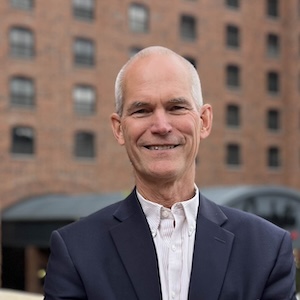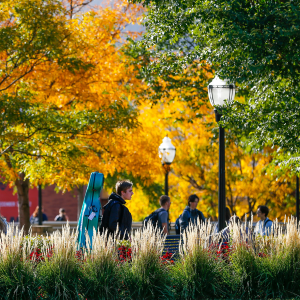Professor James Luby
James Luby is former acting Director of Graduate Studies of the Master of Professional Studies in Horticulture. He was Director of Graduate Studies of the program when it was known as the Master of Agriculture, and until recently, led the wine grape breeding program. When not in the lab, Luby teaches the popular course Hort 1031 Vines and Wines.
Crisp. Juicy. Sweet. Maybe a little tart. We all know what we like in an apple. But do you know the science that goes on behind the scenes to achieve that perfect flavor and mouth-feel? Professor James Luby does.
“Wonderfully crunchy and juicy”
The famed Honeycrisp apple began as a modest seedling in the University’s Horticulture Research Center orchard in the 1960s, where it was largely overlooked. Luby and his colleague, Professor David Bedford, came across it again in the 1980s and knew right away that there was something there worth exploring.
Introduced in 1991, the “wonderfully crunchy and juicy” Honeycrisp had a small local following but didn’t really take off until the 2000s. “It’s really just been about the last 10 years that the coasts have been able to taste it, and it’s still spreading,” Luby says.
The apple is now often used in breeding, and Professor Luby has been at the “core” of its expansion. For example, his team crossed Honeycrisp and Zestar!Ⓡ, another breed introduced in the ‘90s with a high sweet and acid flavor, to produce a new variety now known as the SweetangoⓇ apple. And there is more to come.
The Process
Fruit and apple breeding began at the U of M in the 1800s and has been going continuously since 1908 at its current site at the Horticulture Research Center at the Minnesota Arboretum. There, researchers cross-pollinate and make the seeds in the spring and harvest them, upwards of 6,000 a year, in the fall. They get planted in the Center’s orchard, and 5 to 10 years later, the fruit is ready to be tasted.
“Maybe one in 10,000 seedlings gets to be named a commercial apple.”
“Each year you’re filling the pipeline from the back end,” Luby explains. “About one percent or less of seedlings are good enough to go to further testing each year. Those are then grafted to grow on a second test orchard. Out of those, there may be 10-15 that go through another round of tasting. Eventually, some may show a fatal flaw, and some may be good enough to go commercial.”
They also work with a group of orchards across the country that test the seedlings to see how they do on a bigger scale. This larger production weeds out even more candidates. “Maybe one in 10,000 seedlings gets to be named a commercial apple.”
Introducing First Kiss™
The goal of plant breeding is to produce something different or better than what’s already out there, but different or better depends a lot on the crop. In fruit breeding, it’s always about a good eating experience.
"If it’s an apple that’s not worth eating, it doesn’t really count.”
“Quality is huge,” Luby says. “That’s one of the things that separates horticulture crops from field crops. Field crops want yield, bushel per acre. In horticulture crops, we want yield but it’s yield only that can be consumed properly (sometimes called edible or marketable yield). If it’s an apple that’s not worth eating, it doesn’t really count.”
Which brings us to the latest Honeycrisp offspring, First Kiss™, a zingy flavored apple with a crisp texture, that should hit stores some time next year. It is the result of crossing the Honeycrisp with a very early ripening apple from Arkansas, the Monark, which colors nicely in the heat but doesn’t store very well. “If you like Haralson, you’ll like this,” says Luby.
Who are Horticulture students?
According to Professor Luby, these multidimensional, self-starting students come to this program because they:
- have a love of plants and want to make a business of it
- are interested in areas such as landscape design, vineyard management, organic farming, seed production, sustainability, ornamental plants
- have some horticulture or business experience and want to gain technical knowledge and formal training
- may even have a biology degree but may not want to go into medicine
- come from many different fields and backgrounds
- want a flexible program that allows them to individualize their curriculum.
Additional photos courtesy of Patrick O'Leary










